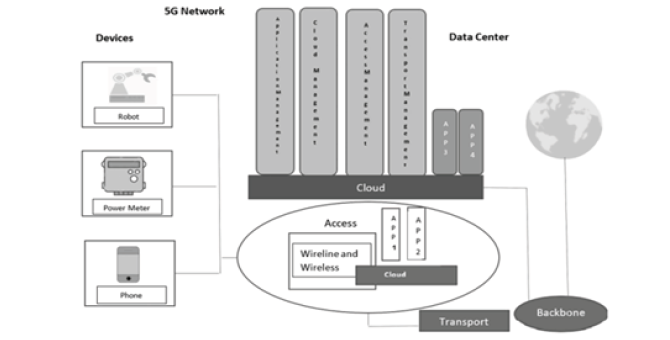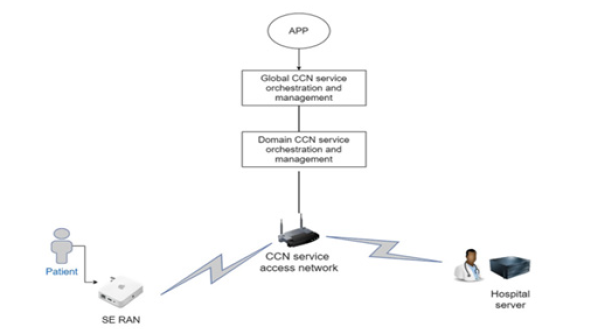Review Article 
 Creative Commons, CC-BY
Creative Commons, CC-BY
The 5G Cardiovascular Network
*Corresponding author: Hiromu Kehara, Department of Surgery, Division of Cardiovascular Surgery, Temple University School of Medicine, USA.
Received: April 16, 2024; Published: May 20, 2024
DOI: 10.34297/AJBSR.2024.22.002985
Introduction
In this digital era, there is a massive growth of apps and connected devices and so the problem of growth is a problem of adaptation. Since communication and consumer privacy are highly desired, to make headway it follows that attention has turned to the 5G network (Figure 1) [1,2].
Although speed and security are the conduits through which both the acquisition and application of knowledge flow, it is the increasing communication that facilitate the transmission of information [1]. It is the new generation of wireless communication using broad band technology that renders increased data rates with a massive number of connections and has become the cornerstone for 5G [1]. The 5G differs from the prior 4G in several advantageous properties. First, the 5G system consists of flexible Radio Access Nodes (RAN) and distributed data centers and central data centers, which are connected by transport networks [1]. Information is stored in data centers and flows from access nodes to data centers in relation to the transport network [1]. Applications will then be run and distributed over the cloud, central to 5G. Unique to 5G lie in its flexibility and that allows for services to be allocated anywhere in the network or to any network. Consequently, these properties have enabled 5G to be ideally suited for various applications in healthcare, smart mobility, social networking, and digital commerce [1]. It is useful here the distinction of the Internet of Things (IoT). The general finding is that demand on the mobile infrastructure will continue to increase with IoT. IoT comprises of a single, flexible, complex platform that connects anyone, anything, anytime and without human intervention [3]. IoT is tantamount to connect all devices to the internet; massive network of devices and network connections that allow things to exchange their data (Figure 2) [4].
Moreover, 5G plays an essential role in providing high-accuracy positioning for the IoT [5]. To achieve this, 5G includes ultralow latency, efficiently utilizing spectrums, catching up with bandwidth and data rate increases, and providing seamless connectivity across technologies [3]. The fundamental design of 5G network is a two-tier hierarchical structure.3 First, there is a Microcell Base Station (MBS), and second, there is a Small Cell Base Station (SBS) [3]. Various SBSs provide the smallest unit of coverage, which are then connected to and overseen by MBS [3]. By having SBS, high data rate is efficiently used, energy consumption is reduced, and performance is enhanced [3]. In the first release of 5G, it was further categorized into three groups: Enhanced Mobile Broad Band (EmBB) with high data rate and greater coverage for cellular devices, Massive Machine Type Connections (MMTC) with machine-to-machine communication, and Ultra-Reliable Low Latency Communication (URLLC) for example remote level surgeries [2]. URLLC, EmBB and MMTC constitute the network architecture. The idea of network slicing is to leverage the network architecture to create multiple subnetworks for different services and applications; e-health, augmented reality, and smart transportation [6]. Network slicing unleashes the full potential of 5G by making an infrastructure intelligent and reduces the dependence on applications for efficiency and latency [7]. Slices of different types for mMTC, URRLC, and eMBB services that utilize the network resources can be created [6]. With the logical network created on top of a single physical infrastructure, each slice meets needs of application with high bandwidth and low latency [7]. Network slicing is especially important for healthcare [6]. Smart healthcare provides healthcare through smart gadgets that process health information such as sensors and biomedical systems and networks [4,8,9]. In healthcare, the IoT plays a role in everything from remote monitoring to smart sensors and medical device integration [9]. In healthcare, the IoT is referred to the “internet of medical things” [4].
IoT consists of six-layered architecture:
i. Coding layer that determines the objects of interest.
ii. The perception layer that interacts via smart devices and physical devices.
iii. The network layer that extracts relevant data from the second layer and transfers it to the middleware layer.
iv. Middleware layer that involves cloud storage and cloud connectivity.
v. Application layer.
vi. Business layer that handles the internet of things program [10].
Since 5G’s speed is 40x that of 4G, 5G is playing a vital role in healthcare systems due to its speed, large coverage area, lower latency, and large bandwidth [4]. To overcome the limitations of wireless body networks, IoT-based 5G-CCN (content-centric network) has been proposed [4,8]. This consists of two components: connection setup and data transmission [4]. IoT-based 5G-CCN address two main challenges: ultra-densification (large number of devices) and high energy consumption [9]. Integral to increasing network capacity is making cells smaller that reduce the distance between users [11]. These are referred to as Heterogenous Networks (HetNets) or Small Cell Networks (SCNs) [11]. Deploying network nodes with local-area ranges thereby making the network closer to end-users, small cells improve coverage and facilitate capacity [11]. Furthermore, small-cell technology enables high efficiency and low-cost network [4]. Small cells have moved away from high-power to low-powered wireless access points that operate in a licensed spectrum with improved cellular coverage, capacity, and applications [12]. However, questions remained as to whether 5G frequencies created interference with pacemakers and Implantable Defibrillators (ICDs) [13,12]. 5G transmitters with their operating frequencies have not been supported to pose additional risk, compared to pre-5G bands [12]. The real-time nature of life-threatening cardiac emergencies may amplify the extent of 5G in some circumstances, rural communities. In this context, time is critical and should not be spent, however, communicating with unsuitable hospitals. One possibility is a patient with an aortic dissection and the closest hospital does not have surgery available. It has been reported that only 58% of hospital transfers meet the expectation of transferring a patient from an ambulance to an emergency department [14]. Along similar lines, in Shanghai one ambulance serves 50,000 residents: a severe shortage of ambulances [14,15]. Ambulances with traditional wireless communication technologies need to overcome several challenges: limited communication capabilities and reliable and high-quality communication capabilities [14]. The 4G network faces barriers of high cost of energy consumption, high demand for ubiquitous coverage, varied quality of service and quality of experience [14]. By contrast, the foundation of 5G enables better data analysis, and works to pool real-time interaction and shares information such as geographical location [14]. Such innovation provides clinicians access to pre-hospital monitoring through the cloud medical information complementary to the information in real time [14].
Most recently, telemedicine is an important part of modern healthcare. To the extent that it allows the capture, storage, and processing of patient data, in particular, patient vital sign data, rescue on-site video information and real-time data exchange [4,14]. Besides storing medical information, this sort of technology captures video on-site pictures and provides medical support for multiple doctors, hospitals, or command centers [14]. The logic also holds for medical wearable devices that actively gather physiological data and track metabolic state [16]. The five main characteristics of wearable technology are: sustainability and durability, interactivity and intelligence, wireless mobility, wearability and portability, and easy operation [16]. A connection is made between the IoT device worn by the patient that stores information in a content store and the server, which receives the information [4]. One may reasonable expect that if another hospital needs access to the patient’s medical data, such access reduces the need to set up another connection [4]. The data is then transmitted to the hospital server. Against this backdrop, patients with life-threatening cardiac conditions are routed to the nearest possible hospital, instead of their own doctor [4]. If a patient’s particular doctor is not available, the information goes to the nearby available hospital. In such cases, the CCN uses a digital signature to secure the patient’s data and the communication between patient and provider is saved in the router [17-19].
Acknowledgment
None.
Declaration of Interest
None.
References
- Ghonge MM, Mangrulkar RS, Jawandhiya PM, Goje N (2021) Future Trends in 5G and 6G: Challenges, Architecture, and Applications (1st ed.). CRC Press.
- Thakkar HK, Dehury CK, Sahoo PK, Veeravalli B (Eds) (2023) Predictive Analytics in Cloud, Fog, and Edge Computing Perspectives and Practices of Blockchain, IoT, and 5G. Springer Link.
- Zhang Ying (2018) Network Function Virtualization: Concepts and Applicability in 5G Networks, John Wiley & Sons, Incorporated, ProQuest Ebook Central.
- Chatterjee P, Bhadoria RS, Pathak Y (2022) 5G and Beyond: The Future of IoT (1st ed.). Chapman and Hall/CRC.
- Kishk, Ahmed editor (2019) The Fifth Generation (5G) of Wireless Communication. Intech Open.
- SM Ahsan Kazmi, Latif U Khan, Nguyen H Tran, Choong Seon Hong (2019) Network Slicing for 5G and Beyond Networks. Springer Link.
- Mastering 5G Network Design, Implementation, and Operations: A Comprehensive Guide to Understanding, Designing, Deploying, and Managing 5G Networks.
- Lal KN, Kumar A (2017) E-health application over 5G using Content-Centric networking (CCN). In 2017 International Conference on IOT and Application (ICIOT) (pp. 1–5). IEEE.
- Ahad M Tahir, KLA Yau (2019) 5G-Based Smart Healthcare Network: Architecture, Taxonomy, Challenges and Future Research Directions. in IEEE Access 7: 100747-100762.
- Gupta M, Chaudhary G, de Albuquerque VHC (2021) Smart Healthcare Monitoring Using IoT with 5G: Challenges, Directions, and Future Predictions (1st ed.). CRC Press.
- (2017) Towards 5G: Applications, Requirements and Candidate Technologies, edited by Rath Vannithamby, and Shilpa Talwar, John Wiley & Sons, Incorporated, ProQuest Ebook Central.
- Vivarelli C, Censi F, Calcagnini G, Ruvo ED, Calò L, et al. (2023) 5G Service and Pacemakers/ Implantable Defibrillators: What Is the Actual Risk? Int J Environ Res Public Health 20(5): 4512.
- Devi DH, Duraisamy K, Armghan A, Alsharari M, Aliqab K, et al. (2023) 5G Technology in Healthcare and Wearable Devices: A Review. Sensors 23(5): 2519.
- Y Zhai, Xing Xu, Baozhan Chen, Huimsin Lu, Yichuan Wang, et al., (2021) 5G-Network-Enabled Smart Ambulance: Architecture, Application, and Evaluation. in IEEE Network 35(1): 190-196.
- Neta Rozen-Schiff, Amit Navon, Itzcak Pechtalt, Leon Bruckman, Yu Boyuan (2023) AQUA: Adding Bandwidth Allocation to QUIC for Metaverse Multi-Stream Applications. IEEE International Conference on Metaverse Computing, Networking and Applications (MetaCom) 762-768.
- Kumar A, Chakravarty S KA, Sharma MK (2023) 5G-Based Smart Hospitals and Healthcare Systems: Evaluation, Integration, and Deployment (1st ed.). CRC Press.ss
- Mattei E, Vivarelli C, Franci D, Pavoncello S, Aureli T, et al. (2023) Pacemakers, Implantable Defibrillators, and 5G Technology: What We Need to Know. Health Phys 125(3): 202-206.
- Radheshyam Singh, Kalpit Dilip Ballal, Stanley C Nwabuona, Michael S Berger, Lars Dittmann, et al. (2022) Assessment of Cellular Coverage for a Smart Ambulance Use Case. 2022 IEEE International Conference on Advanced Networks and Telecommunications Systems (ANTS) 369-374.
- Parfait Ifede Tebe, Guangjun Wen, Jian Li, Yongjun Yang, Wenhong Tian, et al. (2022) 5G-Enabled Medical Data Transmission in Mobile Hospital Systems. IEEE Internet of Things Journal 9(15): 13679-13693.





 We use cookies to ensure you get the best experience on our website.
We use cookies to ensure you get the best experience on our website.